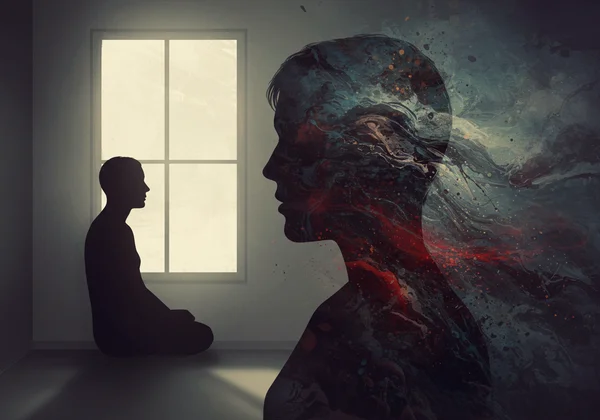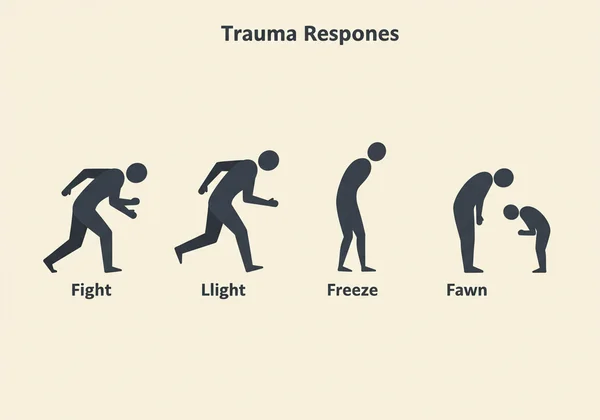Emotional Flashback CPTSD Test: How to Recognize & Cope with Symptoms
Do you ever feel overwhelmed by sudden, intense emotions like shame, fear, or anger that seem completely disconnected from the present moment? This isn't a memory you can see, but a powerful feeling that transports you back to the emotional state of a past trauma. This experience, a hallmark of Complex PTSD, is the definition of an emotional flashback CPTSD. If you’ve ever wondered, "How do I know I'm suffering from PTSD?", understanding this specific symptom is a crucial first step. This guide will help you understand what's happening, why it happens, and how you can begin to manage it with compassion. Getting clarity can be the first step on a healing path, and you can begin to understand your experiences today.
What is an Emotional Flashback in CPTSD?
An emotional flashback is one of the most confusing and distressing cptsd symptoms. Unlike the visual flashbacks commonly associated with classic PTSD, an emotional flashback is a purely emotional regression. It's when you re-experience the painful emotions of a past traumatic period—such as helplessness, shame, or fear—without a visual or narrative memory attached. It feels as if those old, painful feelings are happening right now, making the present moment feel unsafe and overwhelming.
This happens because prolonged or repeated trauma, especially during developmental years, can wire the brain to be in a constant state of high alert. The emotional part of the brain (the amygdala) becomes overactive, triggering intense fear responses to situations that only subtly resemble past threats. Understanding this is not about reliving pain, but about empowering yourself with knowledge.

How It Differs from Classic PTSD Flashbacks
It's vital to distinguish between different types of flashbacks to understand your experience better. This distinction is often a key part of any cptsd self-assessment.
- Classic PTSD Flashbacks: These are often sensory and explicit. A person might see images, hear sounds, or smell odors connected to a specific, single-incident trauma (like a car crash or combat). The flashback is a vivid re-living of a particular event.
- CPTSD Emotional Flashbacks: These are primarily emotional and implicit. They are not tied to one specific event but to the pervasive emotional atmosphere of a prolonged traumatic environment (like ongoing childhood neglect or emotional abuse). You don't see the past; you feel it. This can be more confusing because there isn't a clear memory to explain the sudden wave of emotion.
Common Feelings: The Hijacking of the Present Moment
When an emotional flashback takes over, it can feel like your present-day self has been "hijacked" by a younger, more vulnerable part of you. The emotions are often intense and can feel disproportionate to the current situation. Common feelings include:
- Toxic Shame: A deep, pervasive feeling of being flawed, broken, or worthless.
- Fear of Abandonment: An intense terror of being left alone or rejected.
- Hopelessness and Despair: A crushing sense that things will never get better.
- Sudden Anxiety or Panic: An overwhelming sense of dread or danger without a clear cause.
- Numbness or Detachment: Feeling disconnected from your body, emotions, or the world around you.
Physical Sensations You Might Experience
The body remembers trauma just as much as the mind. During an emotional flashback, you might experience a range of physical sensations that are your body’s alarm system in action. These are not "just in your head"; they are real physiological responses.
You might notice a racing heart, shallow breathing, or tightness in your chest. Some people feel a sense of dizziness or lightheadedness. Others might experience a "freeze" response, feeling suddenly paralyzed, heavy, or unable to move or speak. Recognizing these physical signs is a key part of identifying that you're in a flashback, not in present-day danger. If these signs resonate, taking a free cptsd test online can be a validating step.
Recognizing Common CPTSD Triggers and Outbursts
A crucial part of managing emotional flashbacks is understanding what is a cptsd trigger. For those with Complex PTSD, triggers are often subtle and interpersonal, rather than overt reminders of a single event. They are small cues that your subconscious interprets as a sign that the old danger is present again.
Learning to identify your triggers is not about avoiding them entirely—that's often impossible. It's about recognizing them when they happen so you can respond with awareness instead of reacting on autopilot. This awareness is a cornerstone of healing from complex trauma.
Identifying Your Subtle, Everyday Triggers
Triggers for emotional flashbacks are often embedded in daily life and relationships. They are usually linked to relational dynamics that echo past trauma. Some common examples include:
- A specific tone of voice that sounds critical or dismissive.
- Feeling ignored, unheard, or misunderstood in a conversation.
- Receiving perceived criticism, even if it's gentle or constructive.
- Someone making a decision for you, leading to feelings of powerlessness.
- Feeling pressured or obligated to do something you don't want to do.
- A sense of authority from a boss or partner that feels threatening.
These triggers are deeply personal. What activates one person may not affect another. The first step in healing is often gently exploring what these triggers are for you.
What Does a CPTSD Outburst Look Like?
When a trigger leads to an emotional flashback, it can sometimes result in what might be called a cptsd outburst. It's important to understand that an "outburst" isn't always an external explosion of anger. It can manifest in several ways, often aligning with the "4 F's" of trauma response: Fight, Flight, Freeze, or Fawn.
- Fight: This can look like an angry outburst, irritability, or becoming overly critical and controlling.
- Flight: This might involve suddenly leaving a room, avoiding social contact, or becoming obsessively busy to escape the feeling.
- Freeze: This is an internal implosion. You might shut down, feel numb, dissociate, or find yourself unable to think or speak clearly.
- Fawn: This involves immediately trying to appease the person you perceive as a threat, often by abandoning your own needs and boundaries to keep them happy.
Understanding your primary trauma response can provide profound self-insight and reduce self-blame.

3 Steps to Manage an Emotional Flashback in the Moment
When you're in the grip of an emotional flashback, it can feel like you're lost in a storm. However, with practice, you can learn to become the anchor. These three steps are a practical starting point for navigating these intense experiences and are a core part of the first step in healing CPTSD.
Step 1: Acknowledge and Name What's Happening
The first and most powerful step is to bring your conscious mind online. Simply say to yourself, either internally or out loud: "I am having an emotional flashback." This simple act of naming the experience creates a sliver of separation between your adult self and the overwhelming emotion. It reminds you that the feeling is a memory from the past, not a reality of the present. This isn't about dismissing the feeling, but about contextualizing it.
Step 2: Use Grounding to Anchor in the Present
Once you've named the flashback, the next goal is to bring your awareness back to the safety of the present moment. Grounding techniques use your five senses to connect you to your current environment. A simple and effective method is the 5-4-3-2-1 technique:
-
5: Acknowledge FIVE things you can see around you. (Example: a lamp, a blue cup, a crack in the wall).
-
4: Acknowledge FOUR things you can touch. (Example: the texture of your jeans, the cool surface of a table, your own skin).
-
3: Acknowledge THREE things you can hear. (Example: the hum of a refrigerator, a bird outside, your own breathing).
-
2: Acknowledge TWO things you can smell. (Example: your coffee, a pen, your own laundry detergent).
-
1: Acknowledge ONE thing you can taste. (Example: the remnants of your last drink, or simply the taste of your own mouth).

Step 3: Offer Yourself Compassion, Not Criticism
After a flashback, it's common for the inner critic to show up with messages of shame ("Why can't I control myself?"). The final, crucial step is to actively replace that criticism with compassion. Remind yourself that this is a normal trauma response. It is a sign of what you have survived, not a sign that you are broken. You might say something kind to yourself, like, "This is really hard, but I am safe now. This feeling will pass." Offering yourself this kindness is a radical act of self-healing. Taking a free cptsd test can be an act of self-compassion, providing you with language and validation for your journey.
Turning Confusion into Clarity: Your Healing Path
Understanding emotional flashbacks is a monumental step in the healing journey from Complex PTSD. It allows you to move from confusion and self-blame to clarity and self-compassion. Recognizing these patterns is not about dwelling on the past, but about reclaiming your present and building a more peaceful future. This knowledge empowers you to respond to yourself with kindness and skill when old wounds surface.
Recognizing these symptoms in yourself is a validating first step. If you're seeking a clearer picture of your experiences, consider taking our free CPTSD test. It's confidential, secure, and based on the WHO-endorsed International Trauma Questionnaire (ITQ). Get the personalized insight you deserve and turn confusion into clarity today.
Frequently Asked Questions
What does a CPTSD outburst look like?
A CPTSD outburst doesn't always look like explosive anger. It can be a "fight" response (yelling, irritability), a "flight" response (abruptly leaving, becoming frantic), a "freeze" response (shutting down, dissociating, feeling unable to move), or a "fawn" response (people-pleasing to de-escalate a perceived threat). The type of outburst often depends on an individual's primary learned trauma response.
What is a CPTSD trigger like?
A CPTSD trigger is often a subtle, interpersonal cue rather than a direct reminder of trauma. It can be a tone of voice, a look of disapproval, feeling ignored, or a situation that makes you feel powerless. These triggers activate the emotional memory of past trauma, leading to an emotional flashback where you feel the same helplessness or fear you did in the past.
How can I tell if I have CPTSD?
While only a qualified mental health professional can provide a diagnosis, a key part of answering how can I tell if I have CPTSD is self-education. It involves difficulties in three core areas: affect regulation (managing emotions), self-concept (feeling worthless or ashamed), and relational difficulties (struggling with intimacy and trust), in addition to classic PTSD symptoms. A great starting point for exploration is a reliable screening tool. Our free and anonymous ITQ test online is based on clinical guidelines and can help you see if your symptoms align with those of CPTSD.
Disclaimer: This article is for informational purposes only and is not a substitute for professional medical advice, diagnosis, or treatment. Always seek the advice of your physician or other qualified health provider with any questions you may have regarding a medical condition. The test on this website is a screening tool, not a diagnostic instrument.